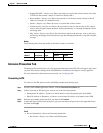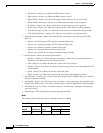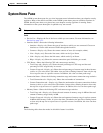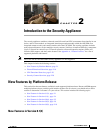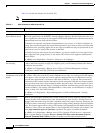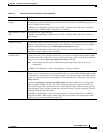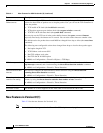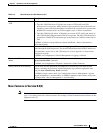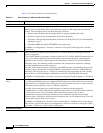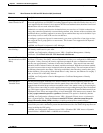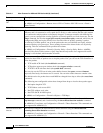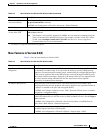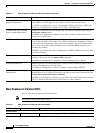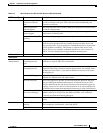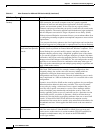
2-5
Cisco ASDM User Guide
OL-16647-01
Chapter 2 Introduction to the Security Appliance
New Features by Platform Release
New Features in Version 8.0(4)
Note These features are not available in Version 8.1(1). See the “New Features in Version 8.1(2)” section on
page 2-1 for many, but not all, of these features. For example, Unified Communications features are not
supported in 8.1(2).
Table 2-2 New Features for ASA Version 8.1(1)
Feature Description
Introduction of the Cisco ASA
5580
The Cisco ASA 5580 comes in two models:
• The ASA 5580-20 delivers 5 Gigabits per second of TCP traffic and UDP
performance is even greater. Many features in the system have been made multi-core
capable to achieve this high throughput. In addition the system delivers greater than
60,000 TCP connections per second and supports up to 1 million connections.
• The ASA 5580-40 will deliver 10 Gigabits per second of TCP traffic and similar to
ASA 5580-20 the UDP performance will be even greater. The ASA 5580-40 delivers
greater than 120,000 TCP connections per second and up to 2 million connections in
total.
In ASDM, see Home > System Resource Status and Home > Device Information >
Environment Status.
NetFlow The new NetFlow feature enhances the ASA logging capabilities by logging flow-based
events through the NetFlow protocol. For detailed information on this feature and the new
CLI commands, see the Cisco ASA 5580 Adaptive Security Appliance Command Line
Configuration Guide.
In ASDM, see Configuration > Device Management > Logging > Netflow.
Timeout for SIP Provisional
Media
You can now configure the timeout for SIP provisional media using the timeout
sip-provisional-media command.
In ASDM, see Configuration > Firewall > Advanced > Global Timeouts.
Details about the activation key You can now view the permanent and temporary activation keys with their enabled
features, including all previously installed temporary keys and their expiration dates
using the show activation key detail command.
In ASDM in single context mode, see Configuration > Device Management > System
Image/Configuration > Activation Key. In ASDM in multiple context mode, see System
> Configuration > Device Management > Activation Key.



